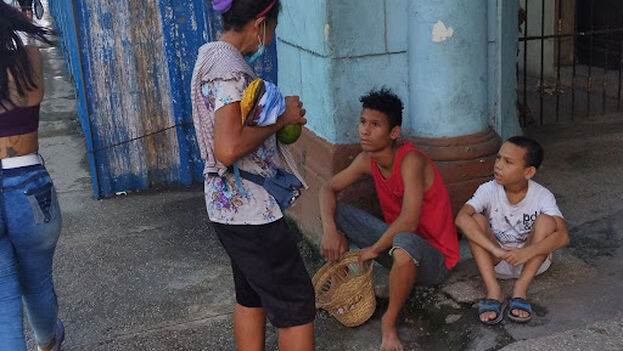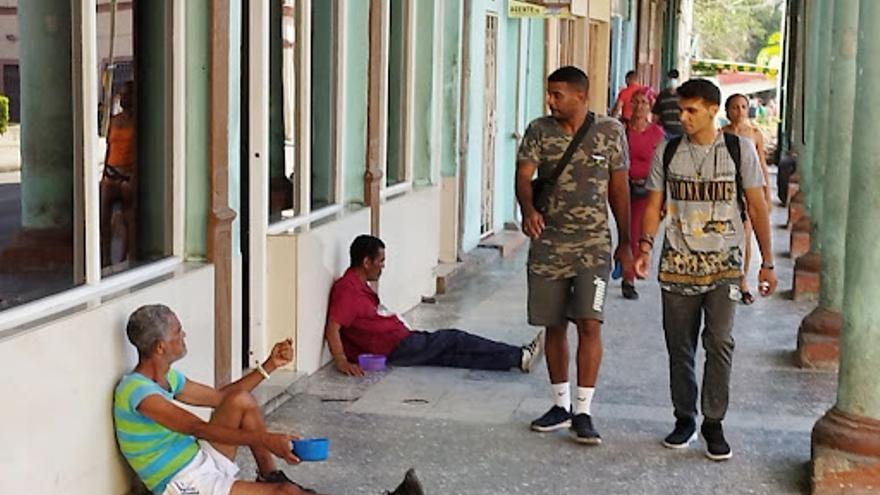
![]() 14ymedio, Juan Izquierdo/Juan Diego Rodríguez, Havana, 9 November 9, 2022 –Ragged, with hollow eyes and a slightly hoarse voice, two children ask for money in Central Havana. The older may be fourteen or fifteen years old, the younger not more than eight. One is barefoot, with curly hair and a face stained by dirt. The other wears a pair of tattered flip-flops.
14ymedio, Juan Izquierdo/Juan Diego Rodríguez, Havana, 9 November 9, 2022 –Ragged, with hollow eyes and a slightly hoarse voice, two children ask for money in Central Havana. The older may be fourteen or fifteen years old, the younger not more than eight. One is barefoot, with curly hair and a face stained by dirt. The other wears a pair of tattered flip-flops.
They ring a bell and extend a wicker basket, taking advantage of the activity at Belascoaín and Carlos III. At the corner where the child beggars operate, an infirm lady, not very presentable, arrives, and she scolds them for begging. “Where’s your family?” she asks them, without the children being able to respond.
The rate of begging on the Island has skyrocketed tragically, and if before you saw only older men begging in the streets, usually alcoholics, now women, the disabled, psychiatric patients, adolescents and children also do so.
The “homeless’ euphemism which the Government has applied to beggars has proven to be a crude simplification. Although many of them, in fact, live on the streets and sleep in the doorways or corners of a dilapidated building, others beg “as a job.” They are located on central avenues and question not only tourists, but also Cubans.
In many cases they are “stationary” beggars; they choose a neighborhood or a specific corner, and learn to take the pulse of their space: the best hours, the faces of passers-by, the precise words to earn a coin or a loaf of bread.
“Most of the adults are very deteriorated from alcohol and age,” Julia, a neighbor of Central Havana, tells 14ymedio. They are the typical drunks, who always carry their plastic bottle to store the chispa, the alcohol of any category they consume. Most are adult men.”

The reason that begging has proliferated so much, says Julia, is due both to the resounding crisis that is going through the Island and the closure of several old-age homes in Havana. “These are things that have a lot to do with it: the collapse of the economy, the emergence of poverty and the forced parental responsibility in the new Family Code. Everything is designed so that the State can wash their hands,” she says.
“On the ground floor of my building,” the woman says, “several beggars ’alternate’. There was an old and very sick one, with a tube from his urine collector, always stained with a bloody liquid. He slept between cartons and right there he urinated and defecated, right in front of the front door.”
Like other neighbors, Julia avoids leaving the building when the beggars are “on guard.” A recent episode of violence confirms this forecast. “Recently, a neighbor came down at ten at night to throw out the garbage and one of them took advantage, pushed the door and tried to enter the building. I don’t know what he intended, whether to lie inside, urinate or settle on the roof.”
“The neighbor tried to bar the way and the man became aggressive. Since then, we never take out the garbage at night,” explains Julia.

Faced with government rhetoric, which closes its eyes to extreme poverty on the Island, the woman insists that there have always been beggars, but now they are increasingly aggressive, and it’s common for them to become “fixed tenants” of doorways and buildings. Even so, they still frequent the “boulevards for beggars” of Havana: Infanta, Carlos III, Belascoaín streets and other central avenues.
“Cubans don’t have a culture of giving money to beggars,” Julia adds. Children are always warned that beggars want someone else to “pay for their vices,” and they use that capital to buy rum or cigars. That’s why it’s uncommon for passers-by who walk through Havana’s long covered sidewalks to place a banknote in the baskets that the homeless extend.
One of the variants that poverty adopts in Havana is that of the “beggar-sellers,” sitting on the ground outside the buildings. “The most notorious thing about their ’goods’,” says Julia, “is that they’re things that are old, used, sometimes dirty, in a variety that goes from pots, casseroles and other kitchen utensils, to equipment, plugs and, of course, broken shoes and old books.”
Translated by Regina Anavy
____________
COLLABORATE WITH OUR WORK: The 14ymedio team is committed to practicing serious journalism that reflects Cuba’s reality in all its depth. Thank you for joining us on this long journey. We invite you to continue supporting us by becoming a member of 14ymedio now. Together we can continue transforming journalism in Cuba.
